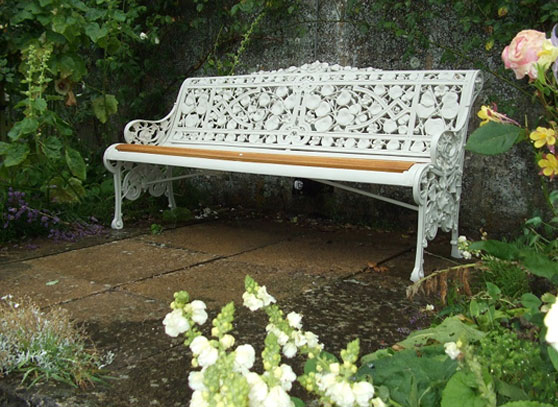Catalogues
Coalbrookdale
Perhaps the most famous of all the foundries producing decorative cast iron goods, Coalbrookdale has a long and distinctive history including considerable innovation within the manufacturing processes as well as true excellence in design.
The Coalbrookdale Foundry was initially established by Abraham Darby of Shropshire in 1709 and run by successive members of the Darby family through most of the 18th Century. The area had previously hosted an earlier foundry but the furnace had exploded and then allowed to become derilict.
Darby rebuilt the Coalbrookdale Furnace, using coke as the fuel and this enabled him to produce simple cast iron goods such as pots and pans more cheaply than his competitors, allowing him to prosper.

The process of using coke as fuel was further refined as the foundry expanded, enabling the company to expand and to make further impacts on hsitory.
They became an early supplier of steam engine cylinders and also the first cast iron rails for the emerging railways. In 1778, the foundry, undertook the work that would ensure a lasting legacy to the world, building the first cast-iron bridge, Iron Bridge, taking two years to complete and still standing today. The foundry had to be further extended in order to cast the bridge.

At the beginning of the nineteenth century, with the spread of wealth within society to include the middle classes, Coalbrookdale developed a wide range of decorative goods, including garden furniture, with the foundry producing vast numbers of benches, chairs, fountains and other goods, such as gates and railings. Many of the original works still exist today and Lost Art Limited have a history of both repairing originals as well as producing high quality reproductions that are to all intents and purposes identical to the 19th century versions

The works produced by Coalbrookdale are also a reflection of the use of high quality design, including the work of the most famous of these, Christopher Dresser, whose designs were not only beautiful but also both influential and revolutionary. He has been described as the first designer of the modern production age and incorporated natural elements into manufacturing design, succesfully bridging the gap between art and industry.
The image shows a Nasturtium bench as illustrated in an original Coalbrookdale catalogue.

The image above shows a reproduction Nasturtium bench produced by Lost Arts and currently residing in a tranquil corner of the garden of a stately home. The bench is available from Lost Art in the same lengths originally offered by Coalbrookdale and we also offer the option of a timber back rather than the cast iron panel.

The popularity of Coalbrookdale designs and the weakness of the copyright laws of the time (lasting only for 3 years) meant that many of their designs were soon copied by other foundries and care should be taken in selecting original benches.
Such was the reputation of Coalbrookdale that, following the Great Exhibition in London where the foundry were awarded a council medal in recognition of the remarkable originality of their work, the company were commissioned to construct the gates to Hyde Park in London.

As with many others of the great decorative foundries, the Coalbrookdale fortunes were greatly affected by the World Wars. For Coalbrookdale the situation was further complicated by the fact that the owning family, The Darbys were also Quakers and so until 1917 they would not involve themselves in the manufacture of weapons and munitions.
Following the Wars the foundry, like many others, found the economic conditions very difficult and a series of mergers and takeovers followed which ultimately has seen what remains of the Coalbrookdale Company continues to exist as part of the AGA heating and cooking range manufacturers.
The Lost Art Archive
Having worked on projects involving a numebr of Coalbrookdale fountains, Lost Art Limited now have full sets of patterns to allow for the recreation of existing fountains or to engage in the Victorian practive of creating a unique fountain by combining elements of already exisiting examples.

The fountain shown in the previous image had been removed from its location in Wigan as long ago as the 1930's. Lost Art Limited provided and installed an exact copy of the original fountain.

In addition, Lost Art maintain an ever increasing library of original Coalbrookdale benches and castings which we are able to reproduce to the highest degree of accuracy and specification.
We also have access to a selection of Coalbrookdale archive material including original catalogues of both benches and other items.
